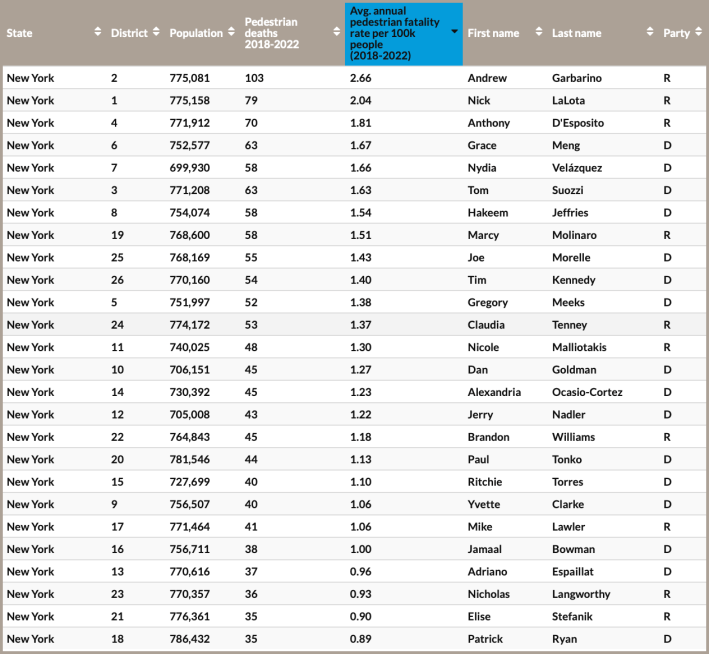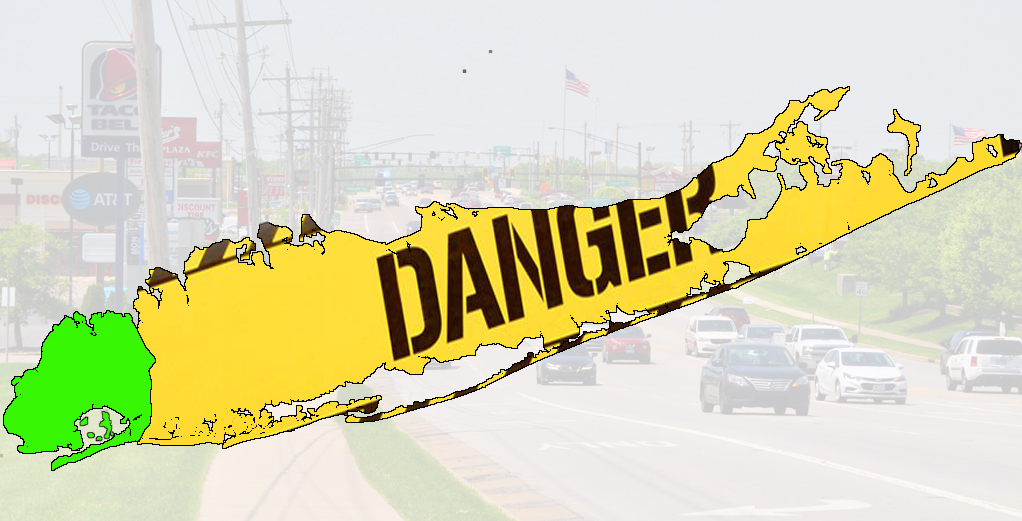They're all Republicans. They all oppose congestion pricing. They all live on Long Island. And they happen to represent the three most-dangerous congressional districts for pedestrians in New York State.
According to crash data newly crunched by Smart Growth America, New York districts 2 and 1 (both in Suffolk County) and District 4 (southwestern Nassau County) are the three worst places to be a pedestrian in the state.
District 2, represented by Andrew Garbarino, had 108 pedestrian deaths between 2018 and 2022, or 2.66 pedestrian deaths per year for every 100,000 residents.
District 1, represented by Nick LaLota, had 79 pedestrian deaths over the same period, or a rate of 2.04 deaths per year.
And District 4, represented by former NYPD detective Anthony D’Esposito, had 70 pedestrian deaths, or a rate of 1.81 pedestrian deaths per year.
By comparison, the two safest districts in the country — Pennsylvania's District 17 and Minnesota's District 2, both represented by Democrats — have death rates of 0.48 and 0.49 respectively. New York State's safest district — District 18 in the northern suburbs, also represented by a Democrat — has a death rate of 0.89 per 100,000 residents.

Road safety is not uniquely a Republican or Democratic failure — some of the nation's most dangerous districts are represented by Democrats and some of the safest are represented by Republicans — but on the local level, Republican leaders on Long Island have often prioritized the needs of car drivers above others, especially pedestrians.
"Our nation’s streets are dangerous by design, designed primarily to move cars quickly at the expense of keeping everyone safe," Smart Growth America said in a statement. "This crisis will continue to get worse until those in power finally make safety for all who use our roads a top priority."
The report does not go into detail as to why the three Long Island districts are so dangerous, but Heidi Simon of Smart Growth America said in an interview that they are united by one similarity: "These representatives have some misperceptions about how their constituents are moving around."
"They assume they are primarily driving ing to get where they want to go, so that's what the representatives prioritize," added Simon, the group's director of thriving communities.
For example, Garbarino, LaLota and D'Esposito oppose congestion pricing, even though the majority of their constituents who commute into the congestion pricing zone do so via transit.
And both Garbarino and LaLota were silent when Suffolk County let its red-light camera program expire amid charges that lawmakers hid rather than defended the program.
Meanwhile, D'Esposito has been a strong supporter of law enforcement, funneling federal transportation money towards police equipment, albeit for license plate readers to help catch scofflaws.
He did secure $600,000 for "transit-oriented development" in Island Park, but that money only went to repaving and improving existing parking lots for cars.
On congestion pricing, he claimed that Long Islanders don't take transit because they “are scared” that they will be "getting thrown in front of a train.”
All three lawmakers have hailed their efforts to win federal money for road improvement projects in their district, but when New York Sens. Chuck Schumer and Kirsten Gillbrand announced a nearly $4-million planning and design grant for the Long Island Greenway, none of the three GOP congressmen served as the House sponsor of the earmark, Newsday reported.
Nor did they want their names connected to a $1.5-million grant for Shore Road improvements in Port Washington — a plan that includes "a walkable/bikeable path with amenities."
Obviously, most road safety efforts start at the village or town level, with mayors and town council members approving a design change and then seeking state and federal money to pay for it. But the pattern shows that road safety initiatives are not a top priority, even though many Suffolk and Nassau constituents — especially in the less-affluent areas of D'Esposito's district — do not drive.
The victims in those cases tend to disproportionately be people of color and low-income residents, Simon said.
Long Island-based lawyer Daniel Flanzig, who works with victims of crashes said the fatality numbers "are not a surprise."
"When I speak with local law enforcement, they tell me that crashes are happening at historically high speeds," he said, adding that D’Esposito's district includes Hempstead Turnpike, which Bicycle Magazine once called the most dangerous road in the country.
"And Freeport and Hempstead have a number of larger arterial roadways going through residential areas," Flanzig said. "Crossing these roads is analogous to the old Queens Boulevard."
Flanzig agreed that road safety is not central to the job description of a member of Congress, but added, "It is still their districts and they owe a duty to keep their constituents safe. ... If these deaths were being caused by firearms or something other than what has seems to become acceptable to local pols, they would intervene. When deaths involve traffic violence, there are less likely to be proactive."
Or, as Simon put it, "Are we going to keep perpetuating policies that leave vulnerable road users unsafe or are we going to fix that status quo?"
Spokespeople for LaLota and D'Esposito did not respond to Streetsblog's queries. But Garbarino sent over a statement through a spokesperson that recalled his party-defying vote to support President Biden's infrastructure effort. The statement did not address road safety for pedestrians, however:
“Facilitating infrastructure improvements on Long Island has been a top priority of mine throughout my time in Congress, which is why I am proud to have secured direct federal funding for such projects across NY-02 and to have cast my vote for the Infrastructure Investment and Jobs Act which delivered millions for road repairs and improvements throughout my district," he said. "Not only is this critical for public safety, but also for the economic prosperity of our communities.”






